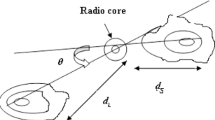Abstract
In this paper, we investigate the relativistic beaming effects in a well-defined sample of core-dominated quasars using the correlation between the relative prominence of the core with respect to the extended emission (defined as the ratio of core-to lobe-flux density measured in the rest frame of the source) and the projected linear size as an indicator of relativistic beaming and source orientation. Based on the orientation-dependent relativistic beaming and unification paradigm for high luminosity sources in which the Fanaroff-Riley class-II radio galaxies form the unbeamed parent population of both the lobe- and core-dominated quasars which are expected to lie at successively smaller angles to the line of sight, we find that the flows in the cores of these core-dominated quasars are highly relativistic, with optimum bulk Lorentz factor,γ opt∼ 6–16, and also highly anisotropic, with an average viewing angle, ∼ 9°–16°. Furthermore, the largest boosting occurs within a critical cone angle of ≈ 4°–10°.
Similar content being viewed by others
References
Antonucci, R. 1993,ARA&A,31, 473.
Barthel, P. D. 1989,Ap. J.,336, 606.
Barthel, P. D. 1994, In:The First Stromlo Symposium: Physics of Active Galaxies, (ed.) G. V. Bicknell, M. A. Dopita, P. Quinn. (Cambridge: Cambridge Univ. Press) p. 175
Barthel, P. D., Miley, G. K. 1988,Nat.,333, 318.
Blandford, R. D., Königl, A. 1979,Ap. J.,232, 24.
Blandford, R. D., Rees, M. J. 1974,MNRAS,169, 395.
Falcke, H., Malkam, M. A., Biermann, P. L. 1995a,A&A,298, 375.
Falcke, H., Gopal-Krishna, Biermann, P. L. 1995b,A&A,298, 395.
Fanaroff, B. L., Riley, J. M. 1974,MNRAS,167, 13p.
Fanti, R., Fanti, C., Schilizzi, R. T., Spencer, R. E., Nan Rendong, Parma, P., van Breugel, W. J. M., Venturi, T. 1990,A&A,231, 333.
Ghisellini, G., Padovani, P., Celotti, A., Maraschi, L. 1993,Ap. J.,407, 67.
Gopal-Krishna 1995,Proc. Natl. Acad. Sci.,92, 11399.
Hough, D. H., Readhead, A. C. S. 1989,AJ,98, 1208.
Kapahi, V. K., Saikia, D. J. 1982,JAA,3, 465.
Kapahi, V. K. 1989,Ap. J.,97, 1.
Laing, R. A., Riley, J. M., Longair, M. S. 1983,MNRAS,204, 151.
Morganty, R., Oosterloo, T. A., Reynolds, J. E., Tadhunter, C. N., Migenes, V. 1997,MNRAS,284, 541.
Murphy, D. W. 1990, In:Parsec-Scale Radio Jets, (ed.) J. A. Zensus, & T. J. Pearson, (Cambridge: Cambridge Univ Press) p. 298
Murphy, D. W., Browne, I. W. A., Perley, R. A. 1993,MNRAS,264, 298.
Neeser, M.4 J., Eales, S. A., Law-Green, J., Leahy, J. P., Rawlings, S. 1995Ap. J.,451, 76.
Nilsson, K., Valtonen, M. J., Jaakola, T. 1993,Ap. J.,413, 453.
Orr, M. J. L., Browne, I. W. A. 1982,MNRAS,200, 1067.
Padovani, P., Urry, C. M. 1992,Ap. J.,387, 449.
Rees, M. J. 1971,Nat.,2229, 312.
Saikia, D. J., Jeyakumar, S., Wiita, P. J., Sanghera, H., Spencer, R. E. 1995,MNRAS,276, 1215.
Saikia, D. J., Kulkarni, V. K. 1994,MNRAS,270, 897.
Scheuer, P. A. G. 1974,MNRAS,166, 513.
Scheuer, P. A. G. 1977, In:Radio Astronomy and Cosmology, IAU Symp 74, (ed.) D. L. Jauncy (Dordrecht: Reidel), p. 434.
Simpson, C. 1996,Vistas Astron.,40, 57.
Singal, A. K. 1993,MNRAS,263, 139.
Ubachukwu, A. A. 1998,Ap&SS,257, 23.
Ubachukwu, A. A. 1999,Publ. Astron. Soc. Aust.,16, 130.
Ubachukwu, A. A. 2002,Ap&SS,279, 251.
Ubachukwu, A. A., Ogwo, J. N. 1998,AJP,51, 143.
Urry, C. M., Padovani, P. 1995,PASP,107, 803.
Vermeulen, R. C. 1995, In:Quasars and AGN: High Resolution Imaging, (ed) M. H. Cohen & K. I. Kellermann (Washington DC: National Academy of Science), p. 11385
Vermeulen, R. C., Cohen, M. H. 1994,Ap. J.,430, 467.
Author information
Authors and Affiliations
Rights and permissions
About this article
Cite this article
Ubachukwu, A.A., Chukwude, A.E. On the relativistic beaming and orientation effects in core-dominated quasars. J Astrophys Astron 23, 235–242 (2002). https://doi.org/10.1007/BF02702285
Received:
Accepted:
Issue Date:
DOI: https://doi.org/10.1007/BF02702285




